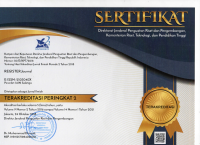Stance Expressions in Introduction of English Research Articles written by Cambodian Authors
Abstract
Stance Expression indicates feelings, certainty or uncertainty, and interests of the authors. As the increasing needs of the readers on significant findings from the introduction section of Research Articles, a study on Stance Expression of introduction section in the English research articles written by Cambodian authors has been conducted to employ crucial aims of the study: (1) examine stance expression types and the categories of each type; (2) compare the similarities and differences of stance expression types used in the introduction section of English RAs written by Cambodian authors published in local and international journals. Thirty research articles written by Cambodian authors published in local and international journals were used in this study. To fulfill these research objectives, the mixed-method research design was utilized in this study. All the four stance features, such as Hedges, Boosters, Attitude Markers, and Self-expression, proposed by Hyland (2005) were used as a Lexical analysis framework model in this study. The results revealed that four stance expression types were found in this study. The hedge was the most frequently employed among the other types of stances. There is a significantly different in terms of the frequencies of hedge used within both RA journals, but there is no for booster, attitude marker, and self-mention. Local Cambodian authors should follow the international authors as models in applying stance in their RAs. A comparison study of the stance expression and engagement between Cambodian and international authors in the introduction should be expanded more different articles from available journals.
Keywords: English research article, introduction section, stance expression, local journals, international journals
Full Text:
PDFReferences
Abdi, J., & Sadeghi, K. (2018). Promotion through claiming centrality in L1 and L2 English research article introductions. International Journal of English Studies, 18(1), 53-70.https://doi.org/10.6018/ijes/2018/1/297381
Alghazo, S., Al Salem, M. N., Alrashdan, I., & Rabab'ah, G. (2021). Grammatical devices of stance in written academic English. Heliyon, 7(11), e08463. https://doi.org/10.1016/j.heliyon.2021.e08463
Ashofteh, Z., Shirvan, M. E., & Golparvar, S. E. (2020). The move structure of abstracts in applied linguistics research articles in light of the distribution and fuctions of metadiscourse markers. Journal of Language and Linguistic Studies, 16(4), 2077-2096.https://doi.org/10.17263/jlls.851035
Baker, S. E., & Edwards, R. (2012). How many qualitative interviews is enough? Retrieved from:https://eprints.ncrm.ac.uk/id/eprint/2273/4/how_many_interviews.pdf
Çakır, H. (2016). Native and non-native writers’ use of stance adverbs in English research article abstracts. Open Journal of Modern Linguistics, 6(02), 85. 10.4236/ojml.2016.62008
Creswell, J. W. (2012). Educational research: planning. Conducting, and Evaluating, 260, 375-382.
Getkham, K. (2016). Authorial Stance in Thai Students' Doctoral Dissertation. English Language Teaching, 9(3), 80-95. http://dx.doi.org/10.5539/elt.v9n3p80
Hamp-Lyons, L., & Heasley, B. (2006). Study writing: A course in written English for academic purposes. Cambridge University Press.
Hyland, K. (2005). Stance and engagement: A model of interaction in academic discourse. Discourse studies, 7(2), 173-192.https://doi.org/10.1177/1461445605050365
Incharoensak, M. C. (2018). Hedges and boosters in US college application essays: A corpus-based comparative study between US middle and US top college application essays (Doctoral dissertation, Doctoral dissertation, Thammasat University).http://ethesisarchive.library.tu.ac.th/thesis/2018/TU_2018_5921042080_8590_9697.pdf
Karahan, P. (2013). Self-mention in scientific articles written by Turkish and non-Turkish authors. Procedia-Social and Behavioral Sciences, 70, 305-322.https://doi.org/10.1016/j.sbspro.2013.01.068
Lancaster, Z. (2016). Expressing stance in undergraduate writing: Discipline-specific and general qualities. Journal of English for Academic Purposes, 23, 16-30.https://doi.org/10.1016/j.jeap.2016.05.006
McHugh, M. L. (2012). Interrater reliability: the kappa statistic. Biochemia medica, 22(3), 276-282.Link: https://hrcak.srce.hr/89395
Miasari, S., Arsyad, S., & Arono, A. (2018). Indonesian authors’ stances in citing English research article introductions literature in sciences. EduLite: Journal of English Education, Literature and Culture, 3(2), 173-187. http://dx.doi.org/10.30659/e.3.2.173-187
Mocănașu, D. R. (2020). DETERMINING THE SAMPLE SIZE IN QUALITATIVE RESEARCH. In International Multidisciplinary Scientific Conference on the Dialogue between Sciences & Arts, Religion & Education (Vol. 4, No. 1, pp. 181-187). Ideas Forum International Academic and Scientific Association.Link: https://www.ceeol.com/search/article-detail?id=936461
Moini, R., & Salami, M. (2015). Stance and engagement discourse markers in journal’s “Author Guidelines”. Journal of Teaching Language Skills, 34(3), 109-140.https://dx.doi.org/10.22099/jtls.2015.3583
Nur, S., Arsyad, S., Zaim, M., & Ramadhan, S. (2021). Interacting With Readers: How Nonnative Authors of English Use Meta-discourse Markers in Their Research Article Abstracts Published in English Medium Journals. Journal of Language and Linguistic Studies, 17(1).Link:https://search.informit.org/doi/abs/10.3316/informit.220608712133406
Papangkorn, P., & Phoocharoensil, S. (2021). A Comparative Study of Stance and Engagement Used by English and Thai Speakers in English Argumentative Essays. International Journal of Instruction, 14(1), 867-888.Link: https://eric.ed.gov/?id=EJ1281921
Petchkij, W. (2019). Explicit teaching of hedges: Bringing hedging in academic writing into the Thai EFL classroom. Electronic Journal of Foreign Language Teaching, 16(1), 95-113.https://e-flt.nus.edu.sg/wp-content/uploads/2020/09/petchkij.pdf
Sandelowski, M. (1995). Sample size in qualitative research. Research in nursing & health, 18(2), 179-183. https://doi.org/10.1002/nur.4770180211
Shen, Q., & Tao, Y. (2021). Stance markers in English medical research articles and newspaper opinion columns: A comparative corpus-based study. Plos one, 16(3), e0247981.https://doi.org/10.1371/journal.pone.0247981
Sukhanindr, M. (2009). Hedging in Research Ariticles about English Language Teaching Written by Thai and Native Speakers of English. Manutsayasat Wichakan, 16(2), 109-120.https://so04.tci-thaijo.org/index.php/abc/article/view/54445
Taki, S., & Jafarpour, F. (2012). Engagement and stance in academic writing: A study of English and Persian research articles. Mediterranean Journal of Social Sciences, 3(1), 157-157. 10.5901/mjss.2012.03.01.157; LINK: 10952-Article Text-41761-1-10-20200419.pdf
Tuan, L. T. (2010). Enhancing EFL Learners' Writing Skill via Journal Writing. English Language Teaching, 3(3), 81-88. https://files.eric.ed.gov/fulltext/EJ1081806.pdf
Wu, B., & Paltridge, B. (2021). Stance expressions in academic writing: A corpus-based comparison of Chinese students’ MA dissertations and PhD theses. Lingua, 253, 103071. https://doi.org/10.1016/j.lingua.2021.103071
DOI: https://doi.org/10.18326/rgt.v15i2.183-200
Refbacks
- There are currently no refbacks.
Copyright (c) 2022 Soeurn Chenda, Safnil Safnil, Syafryadin Syafryadin

This work is licensed under a Creative Commons Attribution-ShareAlike 4.0 International License.










